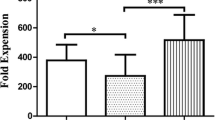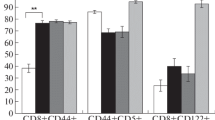Abstract
Spleen cells derived from tumor-bearing mice prove useful for the elucidation of the mechanism determining how tumor cells evade cytotoxic T lymphocytes (CTL) in tumor-bearing hosts. Our data indicate that inactive CTL or precursor CTL specific for tumor antigens are present among lymphocytes of tumor-bearing mice. However, their activity is inhibited by a soluble factor produced by other cells present in the same source. Inhibition of the cytolytic reaction was also detected in the culture supernatant of spleen cells obtained from normal mice, precultured in the presence of tumor cell culture supernatant and interleukin-2 (IL-2). Cell-depletion and cell-purification studies let us conclude that cells that produced the CTL-inhibitory factor (CTL-IF) were γ/δ T cells. The γ/δ T cells that were activated in vivo in tumor bearers were able to produce CTL-IF after isolation and in vitro culture. Maximum activation of γ/δ T cells was achieved by antigenic stimulation and by suppression of cells that interfered with the activation of γ/δ T cells. CTL-IF, which was assayed by use of CTL clones, did not show antigen specificity. Inhibition depended on a relatively heat- and acidstable, but alkali-labile molecule with a molecular mass of less than 10 kDa. The latter characteristics imply that CTL-IF does not resemble any of the known lymphokines produced by γ/δ T cells. These observations emphasize the crucial role of the γ/δ T cells in the escape of tumor cells from the attack of tumorspecific CTL.
Similar content being viewed by others
References
Bensussan A, Lagabrielle J-F, Degos L (1989) TCR γδ bearing lymphocyte clones with lymphokine-activated killer activity against autologous leukemic cells. Blood 73:2077
Bernstein ZP, Goldrosen MH, Vaickus L, Friedman N, Watanabe H, Rahman R, Park J, Arbuck SG, Sweeney J, Vesper DS, Takita H, Zeffren J, Dennin RA, Foon KA (1991) Interleukin-2 with ex vivo activated killer cells: therapy of advanced non-small-cell lung cancer. J Immunother 10:383
Bluestone JA, Cron RQ, Cotterman M, Houlden BA, Matis LA (1988) Structure and specificity of T cell receptor γ/δ on major histocompatibility complex antigen-specific CD3+, CD4−, CD8− lymphocytes. J Exp Med 168:1899
Bonneville MK, Ito, Krecko EG, Itohara Kappes SD, Ishida I, Kanagawa O, Janeway CA, Murphy DB, Tonegawa S (1989) Recognition of a self major histocompatibility complex TL region product by γδ T cell-receptors. Proc Natl Acad Sci USA 86:5928
Boyle W (1968) An extension of the51Cr-release method for the estimation of cytotoxins. Transplantation 6:761
Christmas SE, Meager A (1990) Production of interferongamma and tumor necrosis factor-alpha by human T-cell clones expressing different forms of the γδ receptor. Immunology 71:486
Erard F, Wild M-T, Garcia-Sanz A, Gros GL (1993) Switch of CD8 T cells to noncytolytic CD8−CD4− cells that make TH2 cytokines and help B cells. Science 260:1802
Faure F, Jitsukawa S, Miossec C, Hercend T (1990) CD1c, as a target structure for human T lymphocytes: analysis with peripheral blood γ/δ cells. Eur J Immunol 20:703
Fujimoto S, Greene MI, Sehon AH (1976) Regulation of the immune response to tumor antigens. II. The nature of immunosuppressor cells in tumor-bearing hosts. J Immunol 116:800
Haregervoin A, Soman G, Hom RC, Finberg RW (1989) Human γδ+ T cells respond to mycobacterial protein. Nature 340:309
Ishikawa H, Li Y, Abeliovich A, Yamamoto S, Kaufmann SHE, Tonegawa S (1993) Cytotoxic and interferon γ-producing activities of γδ T cells in the mouse intestinal epithelium are strain dependent. Proc Natl Acad Sci USA 90:8204
Ito H, Kaer LV, Bonneville M, Hsu S, Murphy DB, Tonegawa S (1990) Recognition of the product of a novel MHC TL region gene (27b) by a mouse γδ T cell receptor. Cell 62:549
Kabawat S, Bast RC Jr, Welch WR, Knapp RC, Bhan AK (1983) Expression of major histocompatibility antigens and nature of inflammatory cellular infiltrate in ovarian neoplasms. Int J Cancer 32:547
Kaufmann SHE, Blum C, Yamamoto S (1993) Crosstalk between α/β T cells and γ/δ T cells in vivo: Activation of α/β T-cell responses after γ/δ T-cell modulation with the monoclonal antibody GL3. Proc Natl Acad Sci USA 90:9620
Kaur I, Voss SDV, Gupta RS, Schell K, Fisch P, Sondel PM (1993) Human peripheral γδ T cells recognize hsp60 molecules on Daudi Burkitt's lymphoma cells. J Immunol 150:2046
Kirchner H (1978) Suppressor cells of immune reactivity in malignancy. Eur J Cancer 14:453
Kitayama J, Atomi Y, Nagawa N, Kuroda A, Mutoh T, Minami M, Juji T (1993) Functional analysis of TCR γδ+ T cells in tumor-infiltrating lymphocytes (TIL) of human pancreatic cancer. Clin Exp Immunol 93:442
Kiyohara T, Tanino T, Egawa K (1982) T cell-dependent nonspecific cytotoxicity induced by culture of mouse spleen cells against natural killer-insensitive tumor cells. Jpn J Exp Med 52:201
Loeffler CM, Smyth MJ, Longo DL, Kopp WC, Harvey LK, Tribble HR, Tase JE, Urba WJ, Leonard AS, Young HA, Ochoa AC (1992) Immunoregulation in cancer-bearing hosts: downregulation of gene expression and cytotoxic function in CD8+ T cells. J Immunol 149:949
Mahvi DM, Carper SW, Storm FK, Teal SR, Sondel PM (1993) Overexpression of 27-kDa heat-stock protein in MCF-7 breast cancer cells: effects on lymphocyte-mediated killing by natural killer and γδ T cells. Cancer Immunol Immunother 37:181
Miescher S, Whiteside TL, Carrel S, Fliedner V von (1986) Functional properties of tumor-infiltrating and blood lymphocytes in patients with solid tumor: effects of tumor cells and their supernatants on proliferative responses of lymphocytes. J Immunol 136:1899
Mizel SB, DeLarco JE, Todaro GJ, Farrar WL, Hilfiker ML (1980) In vitro production of immunosuppressive factors by murine sarcoma virus-transformed mouse fibroblasts. Proc Natl Acad Sci USA 77:2205
Mizoguchi H, O'Shea JJ, Longo DL, Loeffler CM, McVicar DW, Ochoa AC (1992) Alterations in signal transduction molecules in T lymphocytes from tumor-bearing mice. Science 258:1795
Morita CT, Verma S, Aparicio P, Martinez-A C, Spits H, Brenner MB (1991) Functionally distinct subsets of human γ/δ T cells. Eur J Immunol 21:2999
Munk ME, Kaufmann SHE (1990) Target cell lysis and IL-2 secretion by γδ T lymphocytes after activation with bacteria. J Immunol 145:2434
Negrier S, Michon J, Bouffet FE, Gentet JC, Philip I, Cochat P, Stamm D, Costil J, Gaspard M, Andreu G, Palmer P, Franks CR, Zucker J, Bernard JL, Fridman WH, Favrot M, Philip T (1991) Interleukin-2 and lymphokine-activated killer cells in 15 children with advanced metastatic neuroblastoma. J Clin Oncol 9:1363
North RJ, Bursuker I (1984) Generation and decay of the immune response to a progressive fibrosarcoma. J Exp Med 159:1295
Okazaki T, Nakanishi-Ito C, Seo N, Tanino T, Takiguchi M, Egawa K (1993) Recognition of the Qa-2k tumor antigen by T cell receptor γ/δ of an immunopotentiator-induced tumoricidal T cell of mice. Cancer Immunol Immunother 36:83
Porcelli P, Brenner MB, Greenstein JL, Balk SP, Terhost C (1989) Recognition of cluster of differentiation 1 antigen by human CD4− and CD8− cytotoxic T lymphocytes. Nature 341:447
Rosenberg SA, Lotze MT, Muul M, Chang AE, Ettinghausen SE, Matory YL, Skibber JM, Shiloni E, Vetto JT, Seipp CA, Simpson C, Reichert CM (1985) Observations on the systemic administration of autologous lymphokine-activated killer cells and recombinant interleukin-2 to patients with metastatic cancer. N Engl J Med 313:1485
Rosenberg SA, Lotze LT, Muul LM, Chang AE, Avis FP, Leitman S, Linehan WM, Robertson CN, Lee RE, Rubin JT, Seipp CA, Simpson CG, White DE (1987) A progress report on the treatment of 157 patients with advanced cancer using lymphokine-activated killer cells and interleukin-2 or high-dose interleukin-2 alone. N Engl J Med 316:889
Rosenberg SA, Packard BS, Aebersold PM, Solomon D, Topalin S, Toy ST, Simon P, Lotze MT, Yang JC, Seipp CA, Simpson C, Capter C, Bock S, Schwartzentruber D, Wei JP, White DW (1988) Use of tumor-infiltrating lymphocytes and interleukin-2 in the immunotherapy of patients with metastatic melanoma: a preliminary report. N Engl J Med 319:1676
Santon TH, Boyse EA (1976) A new serologically defined locus Qa-1, in the T1a region of the mouse. Immunogenetics 3:525
Sarzotti M, Baron S, Klimple GR (1987) EL-4 metastases in spleen and bone marrow suppress the NK activity generated in these organs. Int J Cancer 39:118
Seo N, Okazaki T, Nakanishi-Ito C, Tanino T, Matsudaira Y, Takahashi T, Egawa K (1992) Expression of the Qa-2k phenotype encoded by the Q5k gene on the surface of tumor cells derived from H-2k mice. J Exp Med 175:647
Spaner D, Migita K, Ochi A, Shannon J, Miller RG, Pereira P, Tonegawa S, Phillips RA (1993) γδ T cells differentiate into a functional but nonproliferative state during a normal immune response. Proc Natl Acad Sci USA 90:8415
Tada T, Ohzeki S, Utsumi K, Takiuchi H, Muramatsu M, Li X-F, Shimizu J, Fujiwara H, Hamaoka T (1991) Transforming growth factor-β-induced inhibition of T cell function: susceptibility difference in T cells of various phenotypes and functions and its relevance to immunosuppression in tumor bearing state. J Immunol 146:1077
Tanino T, Seo N, Okazaki T, Nakanishi-Ito C, Sekimata M, Egawa K (1992) Detection of allogeneic Qa/TL and Ly specificities on murine tumor cells with IgD in tumor-regressor serum. Cancer Immunol Immunother 35:230
Ting CC, Rodrigues D, Ting RC, Wivel N, Collins MJ (1979) Suppression of T-cell-mediated immunity by tumor cells. Int J Cancer 24:644
Townsend SE, Allison JP (1993) Tumor rejection after direct costimulation of CD8+ T cells by B7-transfected melanoma cells. Science 259:368
Udono H, Srivastava PK (1993) Heat shock protein 70-associated peptides elicit specific cancer immunity. J Exp Med 178:1391
Vidovic D, Roglic M, McKune K, Guerder S, McKay C, Dembic Z (1989) Qa-1 restricted recognition of foreign antigen by γ/δ T cell hybridoma. Nature 340:646
Webb S, Morris C, Sprent J (1990) Extrathymic tolerance of mature T cells: clonal elimination as a consequence of immunity. Cell 63:1249
Zocchi MR, Ferrarini M, Rugarli C (1990) Selective lysis of the autologous tumor by δTCS1+ γδ+ tumor-infiltrating lymphocytes from human lung carcinomas. Eur J Immunol 20:2685
Author information
Authors and Affiliations
Rights and permissions
About this article
Cite this article
Seo, N., Egawa, K. Suppression of cytotoxic T lymphocyte activity by γ/δ T cells in tumor-bearing mice. Cancer Immunol Immunother 40, 358–366 (1995). https://doi.org/10.1007/BF01525386
Received:
Accepted:
Issue Date:
DOI: https://doi.org/10.1007/BF01525386




